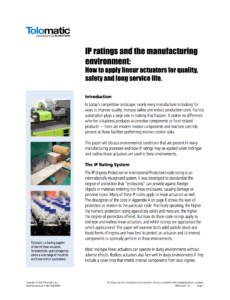IP ratings and the manufacturing environment: How to apply linear actuators for quality, safety and long service life.
Introduction
In today’s competitive landscape, nearly every manufacturer is looking for ways to improve quality, increase safety and reduce production costs. Factory automation plays a large role in making that happen. It makes no difference whether a business produces automotive components or food-related products — there are modern motion components and machine controls present at those facilities performing motion control tasks.
This paper will discuss environmental conditions that are present in many manufacturing processes and how IP ratings may be applied when rod-type and rodless linear actuators are used in these environments.
The IP Rating System
The IP (Ingress Protection or International Protection) code rating is an internationally recognized system. It was developed to standardize the degree of protection that “enclosures” can provide against foreign objects or materials entering into these enclosures, causing damage or personal injury. Many of these IP codes apply to linear actuators as well. The description of the code in Appendix A on page 6 shows the level of protection in relation to the particular code. Practically speaking, the higher the numeric protection rating against dry solids and moisture, the higher the degree of protection offered. But how do these code ratings apply to rod-type and rodless linear actuators, and which ratings are appropriate for which applications? This paper will examine both solid particle (dust) and liquid forms of ingress and how best to protect an actuator and its internal components to optimally perform in these environments.
Most rod-type linear actuators can operate in dusty environments without adverse effects. Rodless actuators also fare well in dusty environments if they include a cover strip that shields internal components from dust ingress.
Dusty Environments
Dusty environments that require linear motion devices are relatively common. For example, dust generated from paper or corrugated materials (cardboard), textiles or normal factory air tends to be dry and relatively light in weight. Most rod-type linear actuators can perform in this type of environment without adverse effects. The addition of rod wipers will further enhance the actuator’s ability to keep dust from its internal components as well as retain the lubrication present inside the actuator. Rodless actuators also can perform well in this type of environment, as many include a type of cover strip that shields internal components from dust ingress. See Figure 1.
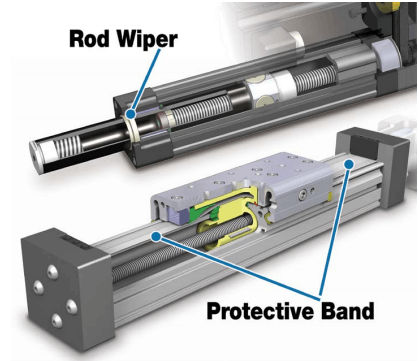
Figure 1: Both rod wipers on a rod-style actuators and protective bands on rodless style actuators help with ingress protection from dusty environments.
Rodless actuators may be enhanced by the addition of a positive pressure port on the body of the actuator designed to equalize internal and external pressures and help keep dust away from possible ingress points. In dusty applications, IP54 would be the minimum rating to consider. An actuator with an IP54 rating is “protected” from dust (5) and splashing water (4), even though splashing water may not be present. In extremely dusty conditions where there are materials being cut (such as in woodworking), or light metal machining and light grinding, the accumulation of dust tends to be considerably heavier. In these applications, a higher rating such as IP65 should be considered, making the device “dust tight” (6) and protected from low-pressure (4.4 PSI) jets of water. Even though there may not be water in the environment, the sealing mechanism for dust exclusion is typically effective for that level of low-pressure water protection. Rod-type actuators that have rod wipers or rod seals also perform well in these conditions; however, rodless actuators typically do not perform well unless some kind of custom-designed protection is applied. Custom-designed protection is best provided by the machinery manufacturer.
Liquid Environments
In applications where water is present, it is important to fully understand the source, direction and volume of the water to which the actuator will be subjected. For example, consider a system in which an actuator is reciprocating a spray head that is directed away from the actuator toward the processed product. Inevitably, some of the water, mist or water vapor will settle back on the actuator. The actuator therefore should have a level of protection against splashing water or against low-pressure jets. See Figure 2. Since the sealing mechanism of most rod-type actuators consists of a rod wiper or rod seal, actuators with a rating of IP65 would be satisfactory. Rodless actuators will experience water ingress at some point unless custom-designed shields or guards are applied.
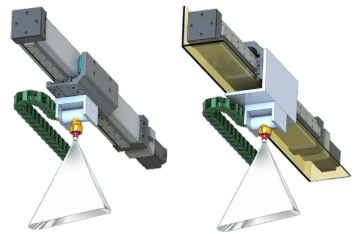
Figure 2: This application depicts a spray head that is directed away from the actuator. The illustration on the left shows a rodless actuator with no shielding that would be suscep-tible to liquid ingress. The illustration on the right shows the proper way to shield a rodless actuator from splashing water or low pressure jets in applications where spray heads are directed away from the actuator.
When an actuator is required to be directly in the path of water for example, the actuator is moving product within the range of sprayed water additional ingress protection is required. IP66- or IP67-rated devices may be more appropriate in this case. Devices with these higher IP ratings will typically have redundant exclusion mechanisms such as shields, bellows or guards, ensuring long-term functionality. Again, rodless actuators will not perform well in these applications without customized protection. See Figure 3.
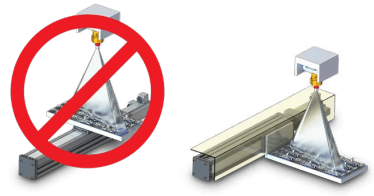
Figure 3: The above application depicts a spray head with direct spray contact to the rodless actuator. The illustration on the left shows a rodless actuator with no shielding. The illustration on the right shows the proper shielding a rodless actuator would require for direct spray applications.
Another common industrial application for actuators is on equipment that requires aggressive cleaning. Equipment used in the preparation of foods and beverages often requires frequent and specific cleaning procedures. In these cases, actuator protection requirements are particularly stringent because food and beverage equipment is often cleaned with aggressive detergent solutions, as well as washed and rinsed with hot (180 degrees Fahrenheit), high-pressure (1,500 PSI) water spray or steam. When specifying actuators for applications such as these, there are two important considerations.
- Understand the chemical makeup of the cleaning solutions. For example, the effects of very high or very low pH cleaning solutions on various components need to be fully understood so the materials used for the sealing mechanism are compatible and do not degrade. This also requires that the metal materials used in the construction of the actuator body be resistant to the particular cleaning solutions.
- Specify sealing materials that are compatible with the cleaning chemicals and resistant to high-pressure and high-temperature water spray. Actuators with a rating of IP69K are best suited for this type of environment. However, it is always wise to perform testing on the solutions used in the process to ensure chemical compatibility.
Applications involving chemical solutions need to be treated somewhat differently than applications involving simple water ingress. IP ratings do not imply chemical compatibility. Knowing exactly what chemicals the actuator will be exposed to will help the actuator supplier select materials most likely to offer good service life. Important factors to consider are the chemical makeup of the solution being used, its concentration level, duration of exposure to components to which it is applied and operating temperatures. This information is critical to applying linear actuators in these types of applications to ensure proper functionality and longevity.
Conclusion
Linear rod-type and rodless actuators are used in a wide variety of manufacturing applications that employ motion control in adverse environments that can expose them to dust, liquids and a variety of chemical solutions. Generally speaking, rod-type products are better suited to these types of conditions. Rodless products can also be employed at ratings of IP54 or less. For higher levels of ingress protection, rodless actuators will typically require some kind of external shields or enclosures to provide the proper protection. The internationally recognized IP coding system standardizes ingress protection levels for machinery components and enclosures. In the case of solid particle protection, these ratings provide guidance on the types of additional components or external protection that are needed to optimize the performance of linear actuators. In the case of liquid ingress protection, IP ratings do not take into consideration the chemical makeup of the solutions; they only rate how resistant “enclosures” are to liquid ingress. For this reason, it is important to understand what liquid solutions are being used and how they affect the components with which they come in contact. This allows the manufacturer to choose compatible components in linear actuators. When selecting linear actuators for applications that require dust and liquid ingress protection, provide the supplier with as much information as possible about the dust and liquids that the actuators will be exposed to in order to ensure environmental compatibility, optimal performance and long service life.
APPENDIX A: International Protection System
Code breakdown

Solid particle protection
The first digit indicates the level of protection the enclosure provides against access to hazardous parts (e.g., electrical conductors, moving parts) and the ingress of solid foreign objects.

Liquid ingress protection
The second digit indicates the level of protection the enclosure provides against harmful ingress of water.
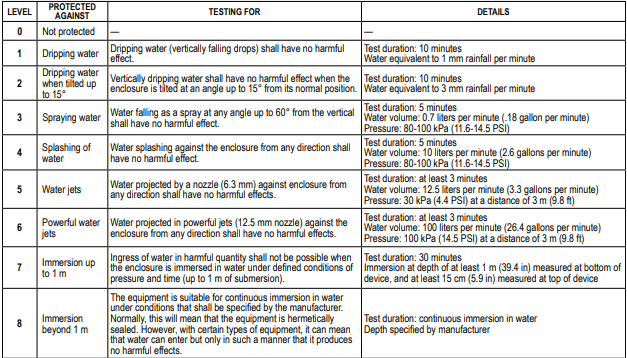
IP69K
IP69K is a German standard DIN 40050-9 and extends the IEC 60529 rating system described above with an IP69K rating for high-pressure, high-temperature wash-down applications. Such enclosures must not only be dust tight (IP6X), but also able to withstand high-pressure and steam cleaning. The test specifies a spray nozzle that is fed with 80°C (176°F) water at 8-10 MPa (80-100 bar) (1160-1450 PSI) and a flow rate of 14-16 L/min (3.7-4.2 gallon /min). The nozzle is held 10-15 cm (3.9-5.9 in) from the tested device at angles of 0°, 30°, 60° and 90° for 30 seconds each. The test device sits on a turntable that rotates once every 12 seconds (5 rpm). The IP69K test specification was initially developed for road vehicles, especially those that need regular intensive cleaning (dump trucks, cement mixers, etc.), but also finds use in other areas (e.g., food industry, car wash centers).

